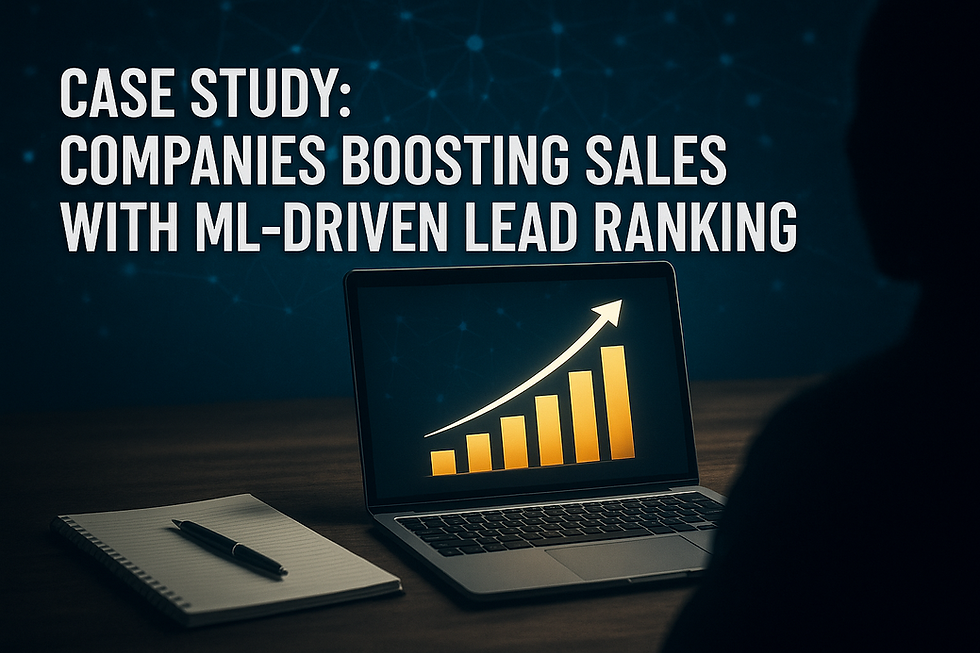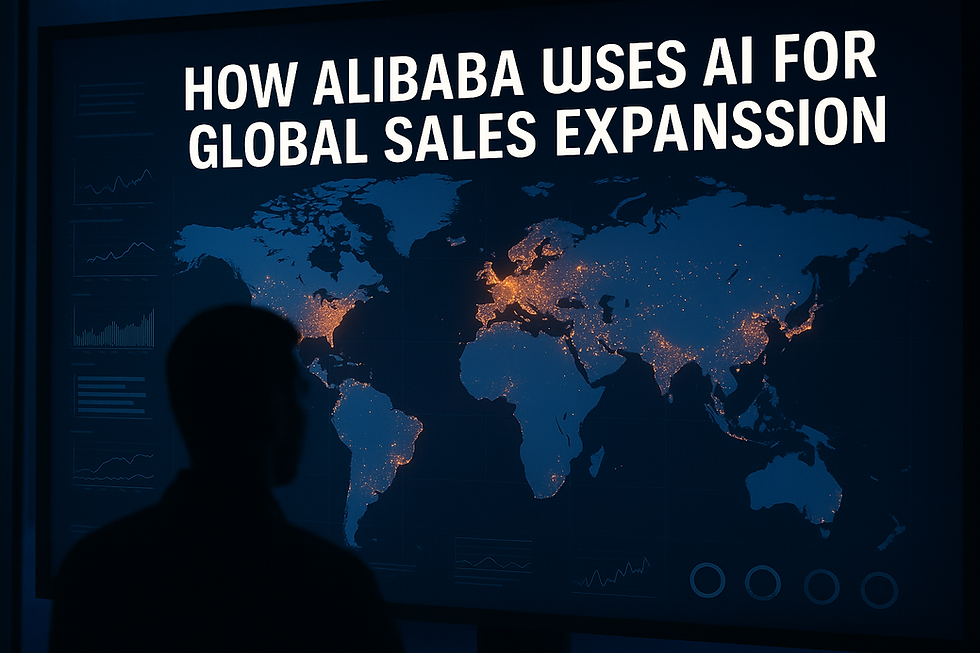5 Real Companies Who Doubled Their Revenue with Machine Learning Powered Sales Strategies
- Muiz As-Siddeeqi

- Aug 21
- 5 min read

5 Real Companies Who Doubled Their Revenue with Machine Learning Powered Sales Strategies
We’re not here to tell bedtime stories.
We’re here to lay down cold, hard, documented facts.
Because in the real world of business, results talk and hype walks.
So when we say “these five companies doubled their revenue using machine learning-powered sales strategies,” we don’t mean vague marketing fluff or theoretical AI buzzwords.
We mean actual documented numbers, published in investor reports, quarterly earnings calls, academic case studies, and business media backed with data.
This is about real businesses. Real teams. Real algorithms. Real dollar growth.
Let’s dive deep. Let’s get emotional. Let’s get analytical.
And most of all — let’s get real.
Bonus: Machine Learning in Sales: The Ultimate Guide to Transforming Revenue with Real-Time Intelligence
The Invisible Hand of Algorithms: How Sales Has Been Quietly Revolutionized
While most businesses are still stuck chasing sales leads manually, crafting “ideal customer profiles” on whiteboards, or flooding inboxes with the same email template……there’s a small group of companies who did something radical.
They handed over key parts of their sales machine to machine learning.
Not to replace their salespeople.
But to supercharge them.
Let’s explore 5 iconic companies — across different industries — who took that leap and came out with jaw-dropping results.
1. Stitch Fix: Doubled Revenue with Predictive ML-Driven Sales Recommendations
Industry: Fashion Retail
ML Use Case: Algorithmic personalization + predictive purchase modeling
Revenue Leap: $343M (FY2017) → $1.58B (FY2020)
Source: Stitch Fix S-1 Filing, Q4 2020 Earnings Reports, Wired Magazine
This is not your average clothing brand.
Stitch Fix doesn’t have brick-and-mortar stores.
They don’t rely on fashion influencers.
Instead, they rely on machine learning.
Their entire sales strategy is driven by a personalization engine that predicts what customers are likely to buy — even before customers know it themselves.
Every time a user orders a clothing “Fix,” Stitch Fix’s algorithm processes:
Their size, color, and style preferences
Historical purchasing patterns
Behavioral data (clicks, returns, keeps)
External trend data and feedback from stylists
The ML models then recommend items with a purchase likelihood score — and sales reps use this data to curate Fixes.
And the results? Earth-shaking.
From $343M revenue in 2017, Stitch Fix skyrocketed to over $1.58B in 2020.
In the words of former CEO Katrina Lake during their S-1 filing:
“We don’t guess trends. We forecast them — algorithmically.”
This was one of the first major use cases of ML-powered human-assisted selling — and it worked. Phenomenally.
2. JD.com: Doubled Sales Volume with ML-Driven Supply Chain + Dynamic Pricing
Industry: E-commerce (China’s second-largest, after Alibaba)
ML Use Case: Intelligent sales forecasting, demand prediction, automated re-pricing
Revenue Jump: $18.5B (2014) → $37.5B (2017)
Source: Harvard Business School Case Study, McKinsey Report on China AI 2018
JD.com’s transformation wasn’t about a chatbot or an email tool. It was a full-blown AI-integrated sales engine from end to end.
JD.com integrated machine learning models across their:
Warehouse inventory forecasting: Predicting demand across 400M+ SKUs
Real-time re-pricing: Changing product prices in milliseconds based on competitor pricing, supply shocks, and customer behavior
Hyperlocal promotions: Matching offers with the right customers based on geographic and behavioral data
The result?
Between 2014 and 2017, JD.com’s total sales volume more than doubled — all while reducing inventory costs by 30% and shrinking delivery times by 57%, according to McKinsey China AI report (2018).
The Harvard Business School case study noted:
“Machine learning didn’t just help JD.com sell more — it helped them sell smarter.”
3. Booking.com: Doubled Conversion Rates Using ML-Based Personalization
Industry: Online Travel & Hospitality
ML Use Case: Predictive conversion optimization and user-specific pricing models
Growth Impact: ~2x lift in mobile booking conversion rate from ML-led testing (2016-2019)
Source: Netflix Tech Blog, Data Council Conference (2019), Booking.com Engineering Blog
When it comes to booking a hotel or planning a trip, user intent is hard to predict.
But Booking.com made it their mission to crack that code with ML.
They built and trained hundreds of machine learning models that:
Identify if a user is a business traveler or vacationer
Predict likelihood of booking based on session behavior
Show tailored pricing, urgency labels, and time-sensitive offers
Re-rank hotels based on likelihood of conversion
According to Booking.com’s engineering team (publicly shared at Data Council SF and multiple academic papers), these systems helped double mobile conversion rates between 2016 and 2019.
What’s more, ML-powered dynamic pricing increased average booking value per customer by over 20%, all while reducing ad spend wastage.
This isn’t guesswork. These were A/B tested across millions of users in live production environments.
4. Spotify: Doubled Premium Subscriptions with ML-Led Behavioral Targeting
Industry: Music Streaming
ML Use Case: Behavioral segmentation for upselling free users to paid subscriptions
Revenue Jump (Premium Subscriptions): 28M (2015) → 70M+ (2017)
Source: Spotify Investor Reports (2015-2017), Recode Interviews, MIT Sloan Case Study
Spotify’s free tier is great. But their real money comes from Premium users.
And to convert free users to paid? They turned to machine learning.
They trained behavioral clustering models on user data like:
How often they skipped ads
When they listened (commute, gym, night)
What devices they used
Which songs they saved or repeated
Then, they created micro-segmented campaigns — sending ML-determined personalized offers at the exact right time (like a gym playlist fan getting a 3-month free Premium offer at 7 a.m. Monday).
The result? Between 2015 and 2017, Spotify more than doubled its Premium user base from 28M to over 70M — while retaining over 85% of converted users, according to Spotify’s Q4 2017 report.
A Spotify product executive shared with Recode:
“Machine learning didn’t just help us sell subscriptions. It helped us understand who we were selling to.”
5. Intuit (TurboTax): Doubled Upsell Revenue with ML-Driven In-App Sales Journeys
Industry: FinTech / Tax Software
ML Use Case: In-product sales nudges and help personalization
Revenue Impact: Upsell revenue doubled from 2016 to 2019 (internal investor presentation; Intuit Q3 2019 call)
Source: Intuit Investor Day Report 2019, Harvard Business Review (2020), CB Insights
TurboTax used to be just a tax-filing software.
Today? It’s an ML-powered sales engine disguised as a tax assistant.
Intuit implemented ML models that guide users through the tax journey, identifying:
If they might need CPA assistance
When to suggest upgrades like TurboTax Live
Where users hesitate or get stuck — triggering in-product nudges
These nudges were predictive, not reactive.
The system offered assistance before the user even clicked “Help,” based on patterns learned from tens of millions of prior users.
And yes — users clicked.
In three years, TurboTax’s in-app upsell revenue doubled, and conversion rates increased over 40% on targeted nudges, according to internal figures shared in Intuit’s 2019 investor briefing.
This is sales automation at its most powerful: invisible, real-time, and behavior-aware.
The Patterns Behind the Profit
After breaking down these case studies, something becomes clear:
Machine learning isn’t replacing sales teams. It’s replacing sales guesswork.
Here’s what these companies had in common:
Behavioral Data: Every winning strategy began with deep behavioral data, not demographic assumptions.
Hyper-Personalization: Offers were tailored not just to users — but to moments.
Real-Time Automation: ML made thousands of micro-decisions in seconds — which no human team could replicate manually.
Sales + ML Collaboration: None of these strategies removed the human touch. Instead, humans worked smarter because ML did the grunt work.
The Bottom Line: Machine Learning Isn’t the Future of Sales. It’s the Present.
This isn’t some Silicon Valley experiment.
These are documented corporate strategies, implemented by some of the most successful companies of the decade.
And every single one of them grew faster, converted better, and sold smarter — because they put machine learning at the heart of their sales strategy.
So if you’re still thinking, “Maybe AI isn’t for us yet”…
Take a breath.
And re-read these names.
Spotify. JD.com. Booking.com. Intuit. Stitch Fix.
Not startups. Not sci-fi.
Real companies. Real machine learning. Real sales revenue growth.

$50
Product Title
Product Details goes here with the simple product description and more information can be seen by clicking the see more button. Product Details goes here with the simple product description and more information can be seen by clicking the see more button

$50
Product Title
Product Details goes here with the simple product description and more information can be seen by clicking the see more button. Product Details goes here with the simple product description and more information can be seen by clicking the see more button.

$50
Product Title
Product Details goes here with the simple product description and more information can be seen by clicking the see more button. Product Details goes here with the simple product description and more information can be seen by clicking the see more button.






Comments